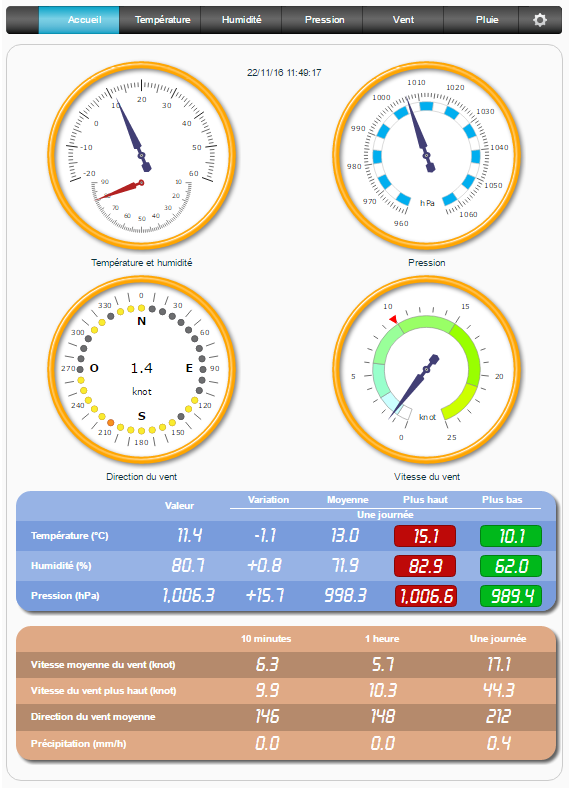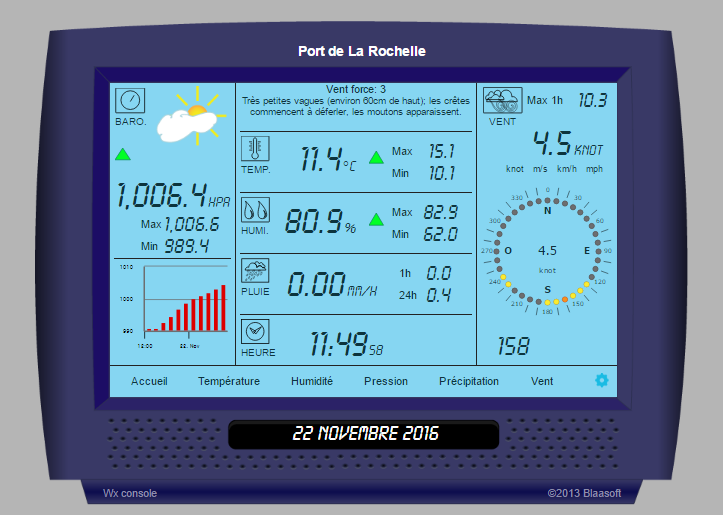Weather
Beaufort Wind Scale
In 1805, Francis Beaufort conceived a scale of classification of the strength of the wind, numbered from 0 to 12 degrees.
This scale, initially intended to improve the precision of the newspapers of edge, is of a universal use in marine meteorology today.
| FORCE | APPELLATION | VITESSE DU VENT | ÉTAT DE LA MER | EFFETS À TERRE | |
| Noeud | Km/h | ||||
| 0 | Calm | 1 | 1 | Sea like a mirror | Calm. Smoke rises vertically. |
| 1 | Light air | 1 to 3 | 1 to 5 | Ripples with the appearance of scales are formed, but without foam crests | Smoke drift indicates wind direction. Leaves and wind vanes are stationary. |
| 2 | Light breeze | 4 to 6 | 6 to 11 | Small wavelets, still short bute more pronounced ; crests have a glassy appearance and do not break | Wind felt on exposed skin. Leaves rustle.Wind vanes begin to move. |
| 3 | Gentle breeze | 7 to 10 | 12 to 19 | Large wavelets. Crests begin to break ; scattered whitecaps | Leaves and small twigs constantly moving, light flags extended. |
| 4 | Moderate breeze | 11 to 16 | 20 to 28 | Small waves with breaking crests. Fairly frequent whitecaps. | Dust and loose paper raised. Small branches begin to move. |
| 5 | Fresh breeze | 17 to 21 | 29 to 38 | Moderate waves of some length. Many whitecaps. Small amount of spray. | Branches of moderate size move. Small trees in leaf begin to sway. |
| 6 | Strong breeze | 22 to 27 | 39 to 49 | Long waves begin to form. White foam crests are very frequent. Some airborne spray is present. | Large branches in motion. Whistling heard in overhead wires. Umbrella use becomes difficult. Empty plastic bins tip over. |
| 7 | High Wind, moderate gale, near gale | 28 to 33 | 50 to 61 | Sea heaps up. Some foam from breaking waves is blown into streaks along wind direction. Moderate amounts of airborne spray. | Whole trees in motion. Effort needed to walk against the wind. |
| 8 | Gale, fresh gale | 34 to 40 | 62 to 74 | Moderately high waves with breaking crests forming spindrift. Well-marked streaks of foam are blown along wind direction. Considerable airborne spray. | Some twigs broken from trees. Cars veer on road. Progress on foot is seriously impeded. |
| 9 | Strong/severe gale | 41 to 47 | 75 to 88 | High waves whose crests sometimes roll over. Dense foam is blown along wind direction. Large amounts of airborne spray may begin to reduce visibility. | Some branches break off trees, and some small trees blow over. Construction/temporary signs and barricades blow over. |
| 10 | Storm, whole gale |
48 to 55 | 89 to 102 | Very high waves with overhanging crests. Large patches of foam from wave crests give the sea a white appearance. Considerable tumbling of waves with heavy impact. Large amounts of airborne spray reduce visibility. | Trees are broken off or uprooted, structural damage likely. |
| 11 | Violent storm | 56 to 63 | 103 to 117 | Exceptionally high waves. Very large patches of foam, driven before the wind, cover much of the sea surface. Very large amounts of airborne spray severely reduce visibility. | Widespread vegetation and structural damage likely. |
| 12 | Hurricane force | 64 and + | 118 and + | Huge waves. Sea is completely white with foam and spray. Air is filled with driving spray, greatly reducing visibility. | Severe widespread damage to vegetation and structures. Debris and unsecured objects are hurled about. |


